
There’s something magical about walking into a living room that instantly makes you want to kick off your shoes and settle in with a good book. After spending countless hours helping homeowners transform their spaces over the past two decades, I’ve discovered that the secret to creating this kind of magnetic comfort lies in embracing earthy, natural elements that speak to our deepest need for connection with the outdoors.
My own journey with earthy design began during a particularly stressful period when I craved nothing more than a sanctuary within my own home. I started experimenting with soft browns, muted greens, and natural textures, and the transformation was remarkable. What had once felt like just another room became a haven where morning coffee tasted better, conversations flowed more easily, and evening relaxation came naturally.
The power of natural colours and organic materials extends far beyond mere aesthetics. These elements tap into something primal within us our innate connection to the natural world. When we surround ourselves with wood, stone, plants, and earth-toned textiles, we’re creating an environment that supports our well-being on a fundamental level.
Creating this kind of space doesn’t require a complete overhaul or an enormous budget. Sometimes the most impactful changes come from thoughtful additions of natural materials and textures that work harmoniously together. The key is understanding how these elements interact and building your room layer by layer, always with comfort and liveability in mind.
10 Natural Touches to Transform Your Living Room into an Earthy Retreat
1. Pair Natural Hues with a White Couch Foundation
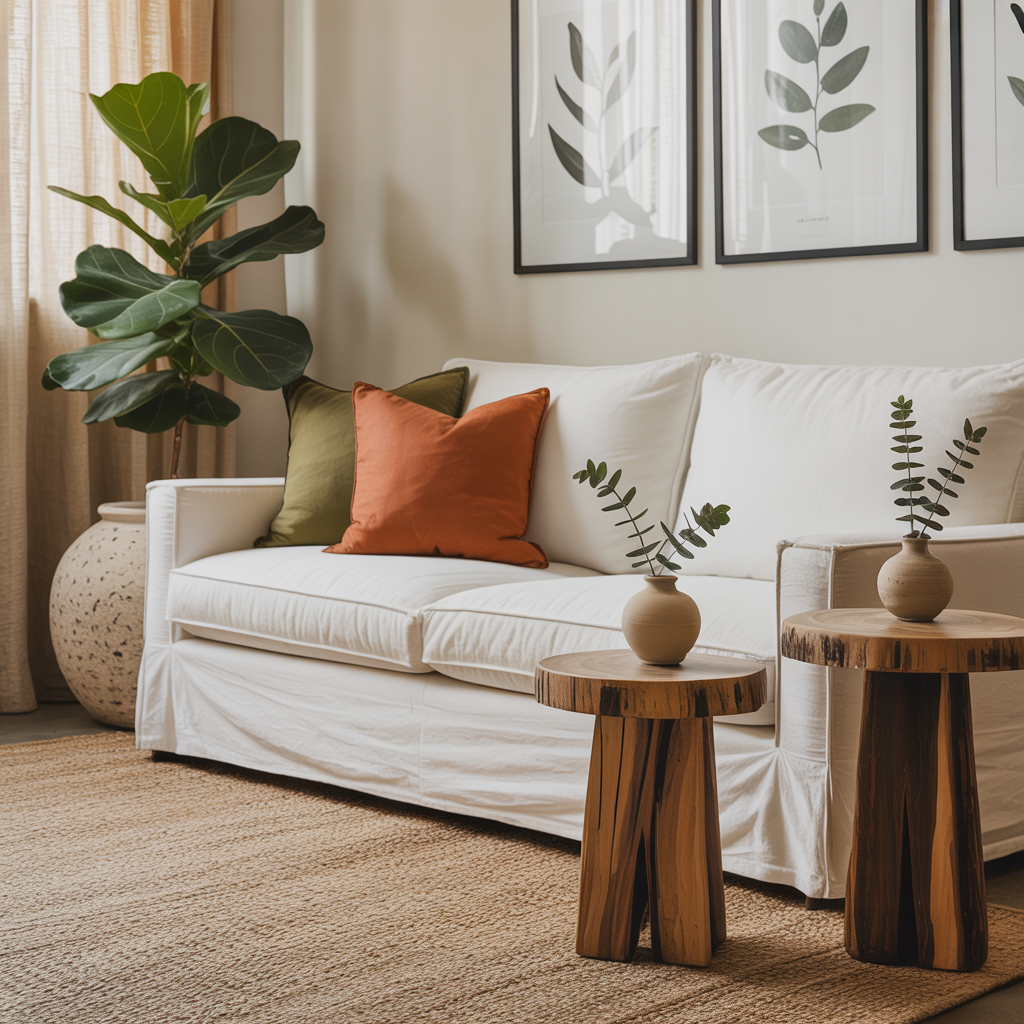
A white couch might seem like an unexpected choice for an earthy living room, but it’s actually one of the most versatile foundations you can choose. The crisp neutrality of white creates a perfect canvas that allows natural elements to truly shine without competing for attention. Think of it as the blank page that lets your story unfold in rich, organic textures and warm tones.
The magic happens when you begin layering natural elements around this clean foundation. Wooden side tables with live edges bring in the raw beauty of tree forms, while botanical prints on the walls connect you to the natural world even when you’re indoors. Linen curtains in warm cream or soft beige add movement and softness, filtering light in the most flattering way possible.
What really brings this combination to life is the addition of living elements. An oversized fiddle leaf fig or a dramatic monstera in the corner doesn’t just add colour it adds life, movement, and that ineffable quality that only living things can provide. The contrast between the structured cleanliness of the white couch and the organic unpredictability of natural elements creates visual tension that keeps the space interesting and alive.
2. Use a Gray Couch as Your Grounding Base
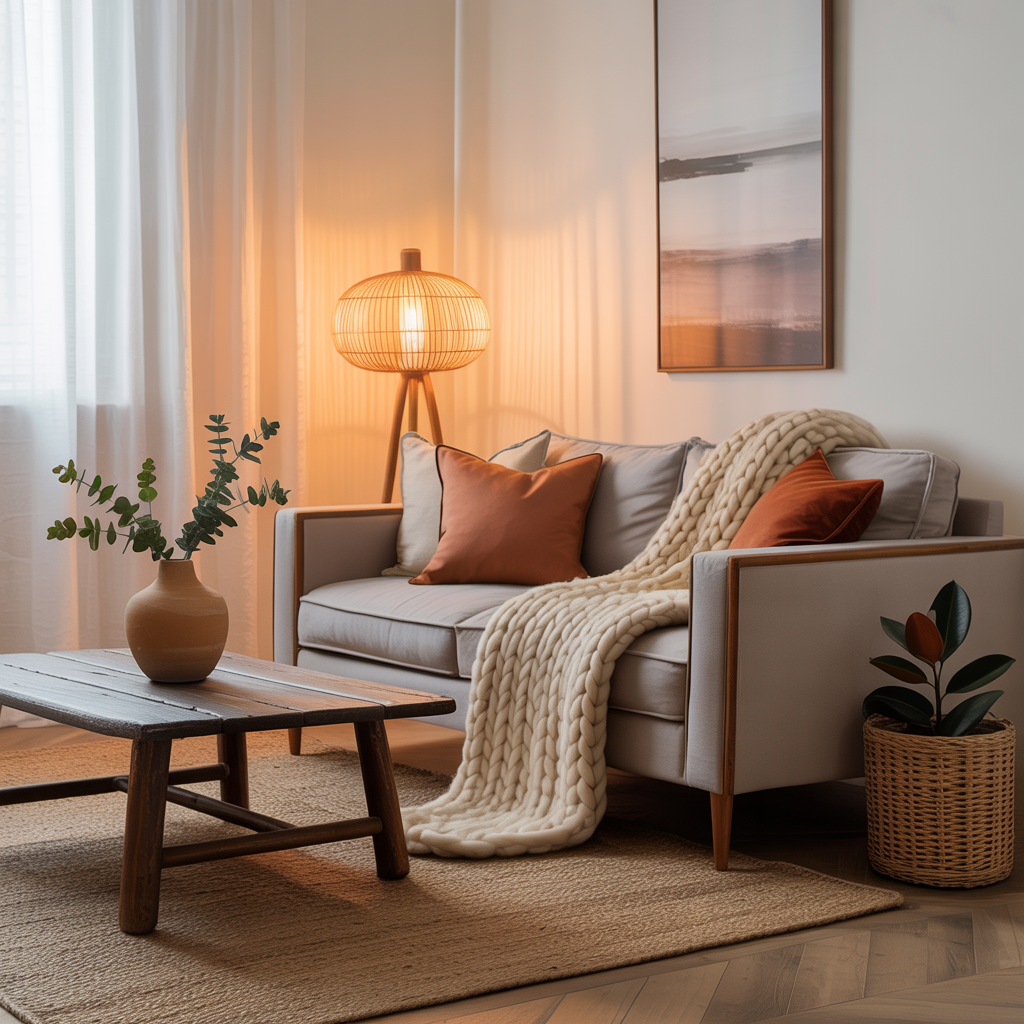
Gray couches have earned their reputation as the chameleons of furniture, but in an earthy living room, they serve a more specific purpose they ground the space with sophisticated neutrality while providing the perfect backdrop for warmer natural elements to pop. Unlike stark white or bold colours, gray has an inherent richness that feels substantial and calming.
The key to making gray work in an earthy scheme is choosing the right undertones and pairing pieces thoughtfully. A gray with subtle brown or green undertones will feel more organic than one with blue undertones. From there, warm wooden side tables, textured throw pillows in rust or terracotta, and a chunky knit throw in cream or oatmeal create layers of tactile comfort that invite touch and relaxation.
Natural texture becomes crucial with a gray foundation. A jute rug underfoot adds rough, organic texture that contrasts beautifully with the smooth upholstery, while a bamboo floor lamp introduces sculptural interest and warm, filtered light. These natural elements prevent the gray from feeling cold or institutional, instead creating a cocoon of sophisticated comfort.
3. Embrace Warm Neutrals with Strategic Green Accents
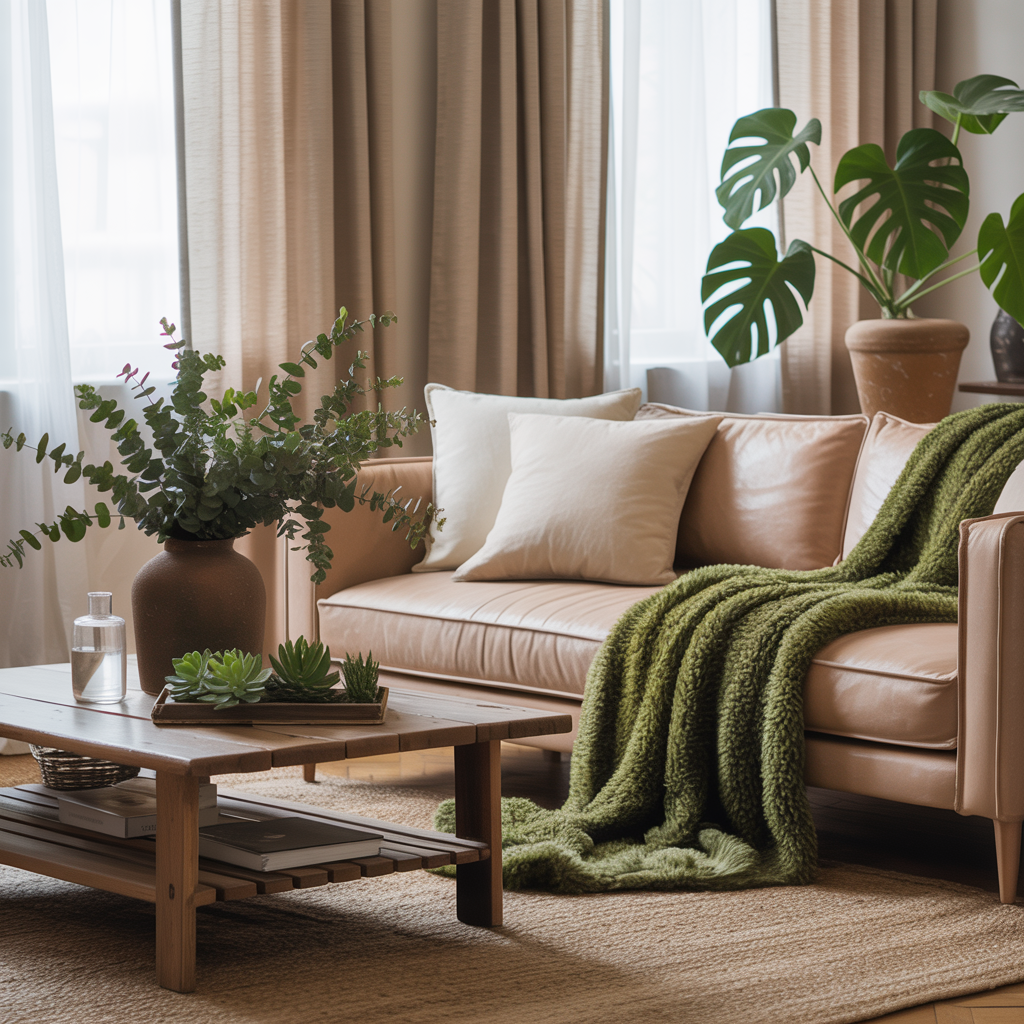
There’s something deeply satisfying about a colour palette that mirrors what you might find on a forest floor sandy beiges, warm creams, and various shades of green that range from sage to olive to deep forest. This combination feels both fresh and timeless, sophisticated yet approachable.
The beauty of this approach lies in its flexibility. A sandy beige couch serves as your foundation, while creamy white textiles add lightness and airiness. The green accents – whether through olive-toned cushions, a moss-colored throw, or eucalyptus branches arranged on your coffee table – bring the energy and life force that keeps the space from feeling flat or monotonous.
Living plants become essential players in this color story. A large monstera plant doesn’t just add green – it becomes a sculptural element that changes throughout the seasons. Small succulents clustered on side tables or shelves create moments of discovery and delight. The key is using different shades and textures of green to create depth and prevent the color from feeling one-dimensional.
4. Create Timeless Elegance with a Brown Couch
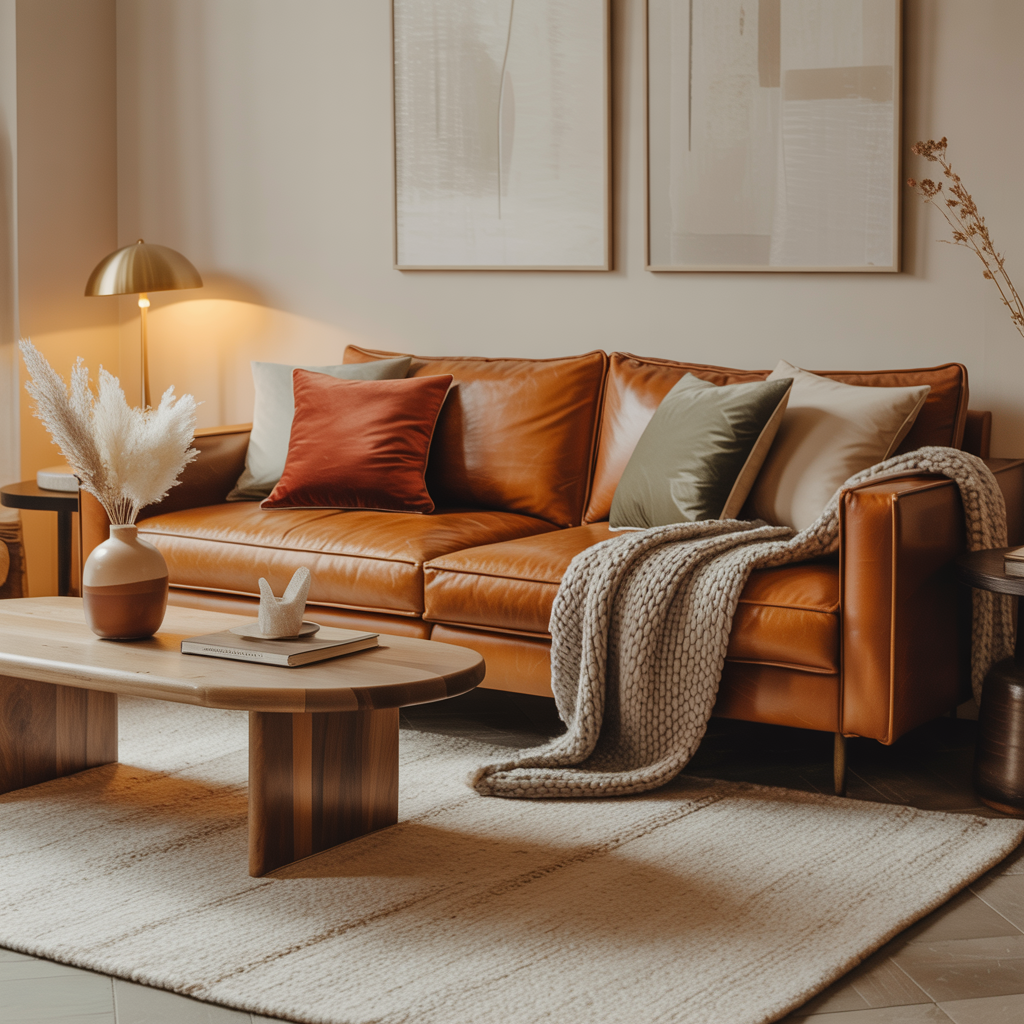
The return of brown furniture marks a shift toward warmer, more grounded interiors, and there’s good reason for this trend. Brown couches, particularly in rich chocolates or warm cognacs, create an immediate sense of coziness and sophistication that’s hard to achieve with other colors. They feel both luxurious and approachable, formal enough for entertaining yet comfortable enough for everyday lounging.
The secret to styling a brown couch successfully lies in balancing its richness with lighter elements that prevent the space from feeling heavy. A cream or oatmeal-colored area rug provides visual breathing room, while earthy-toned pillows in rust, terracotta, or sage add color variation within the same warm family. The textures you choose become especially important – think woven throws, leather accents, and natural wood surfaces that complement rather than compete with the couch’s inherent richness.
What makes brown particularly relevant now is its connection to current color trends. With Pantone naming Mocha Mousse as a significant color influence, brown couches feel both on-trend and timelessly elegant. They create a foundation that will remain stylish for years to come while providing the warmth and comfort that makes a house feel like home.
5. Build a Moody Earthy Aesthetic Around Your Fireplace
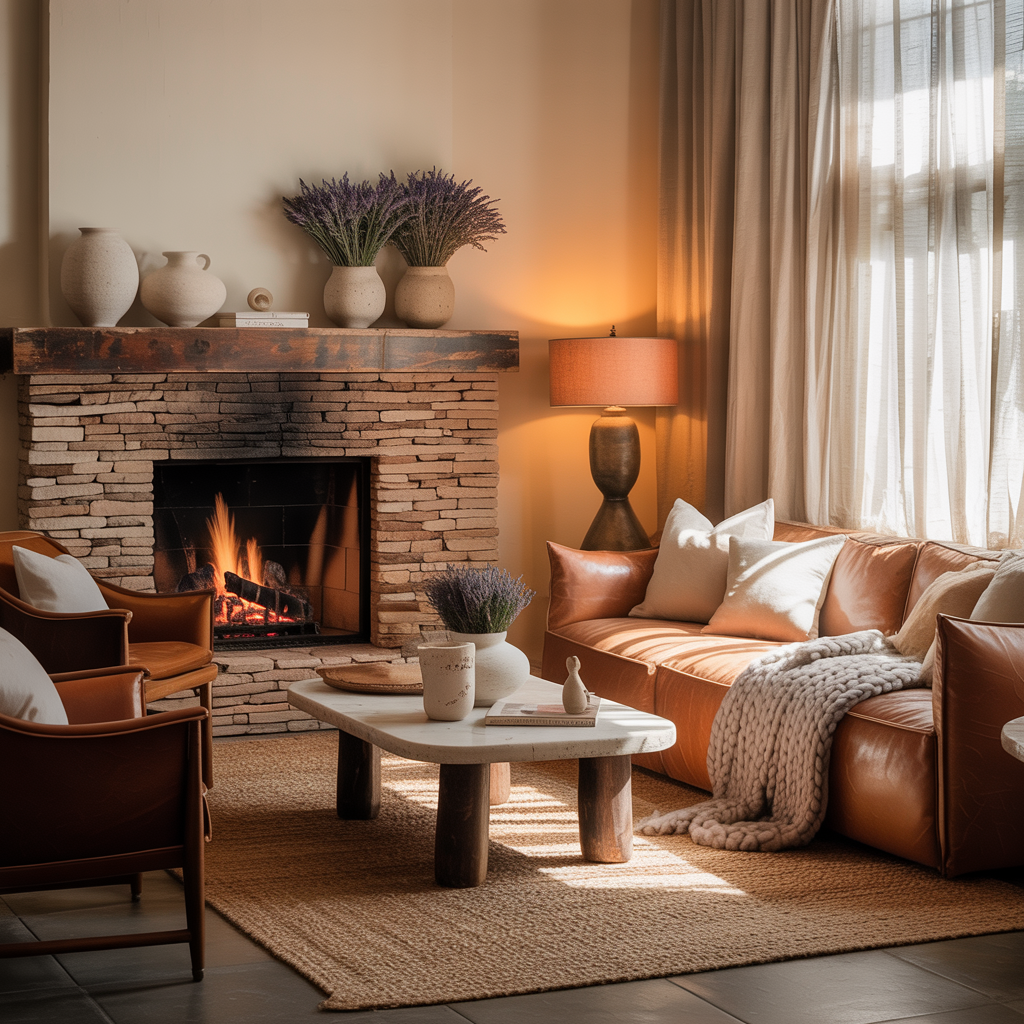
A fireplace is nature’s gift to interior designers it provides warmth, light, ambiance, and a natural focal point that draws people together. When designing an earthy living room around a fireplace, you’re working with one of the most powerful natural elements possible, and the key is to enhance rather than compete with its inherent drama.
The materials you choose for the mantel and surrounding area set the tone for the entire room. Natural stone, reclaimed wood, or even painted brick in warm, earthy tones create a foundation that feels organic and grounded. Personal touches like handmade ceramics, dried botanicals, or a collection of interesting stones and shells make the space feel curated and personal rather than staged.
Seating arrangement becomes crucial in a fireplace-cantered room. Furniture should be positioned to take advantage of both the warmth and the view, encouraging conversation and connection. Layer different textures in your seating linen cushions, chunky knit throws, and a plush area rug underfoot create a tactile richness that complements the visual warmth of the fire. Ambient lighting throughout the room should be soft and warm, supporting rather than competing with the fireplace’s natural glow.
6. Make a Statement with a Green Accent Wall
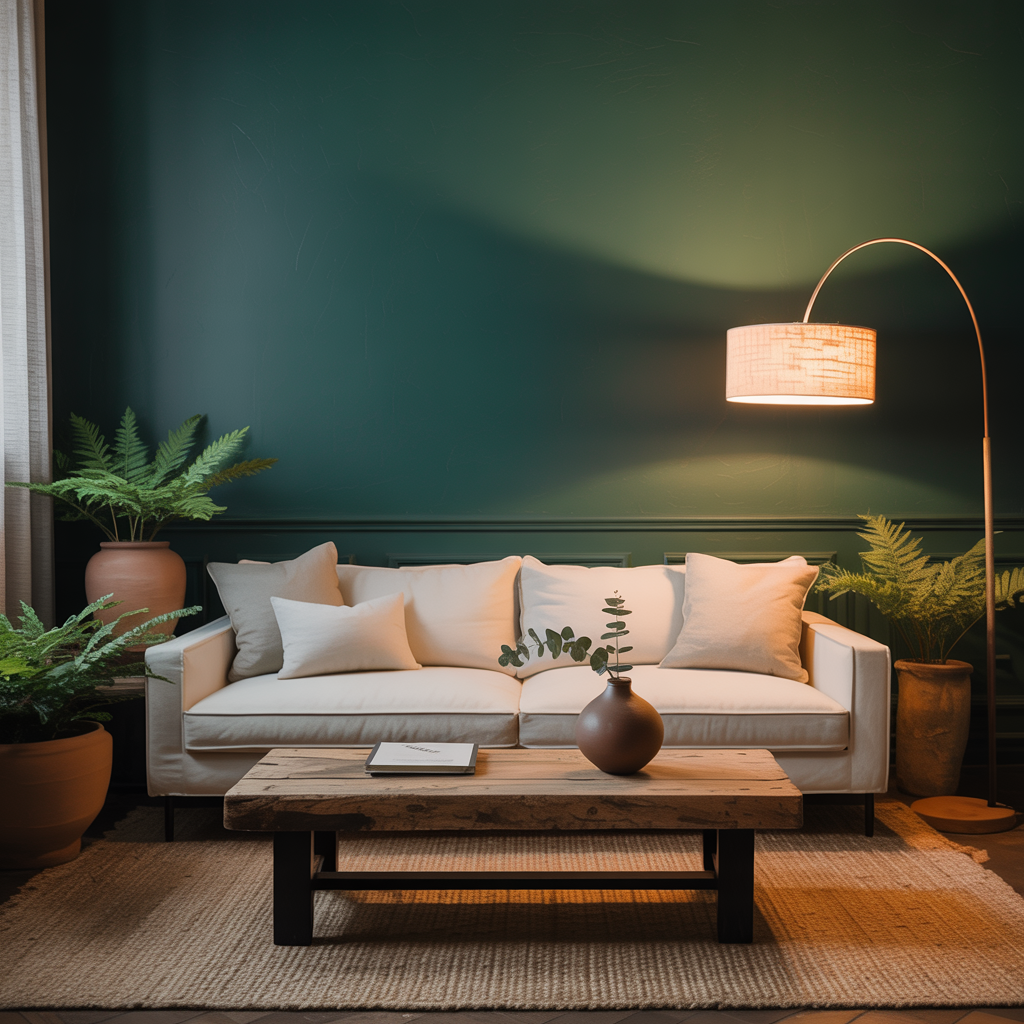
Sometimes the most impactful natural touch is also the boldest. A green accent wall can transform an entire room, bringing the calming, rejuvenating energy of nature indoors in a dramatic and beautiful way. The key is choosing the right shade and balancing it thoughtfully with the rest of your decor.
Deep forest greens work particularly well because they feel rich and sophisticated rather than overwhelming. These darker greens pair beautifully with neutral furniture in beiges, creams, and warm whites, creating a sense of balance that feels both grounded and elegant. The green wall becomes your room’s statement piece, so other elements should support rather than compete with it.
When working with a bold wall color, simplicity becomes your friend. A reclaimed wood coffee table, a sisal area rug, and clean-lined furniture in natural materials create a cohesive look that feels intentional rather than busy. The goal is to let the green wall breathe while surrounding it with elements that enhance its natural beauty.
7. Incorporate Farmhouse Charm with Authentic Rustic Elements
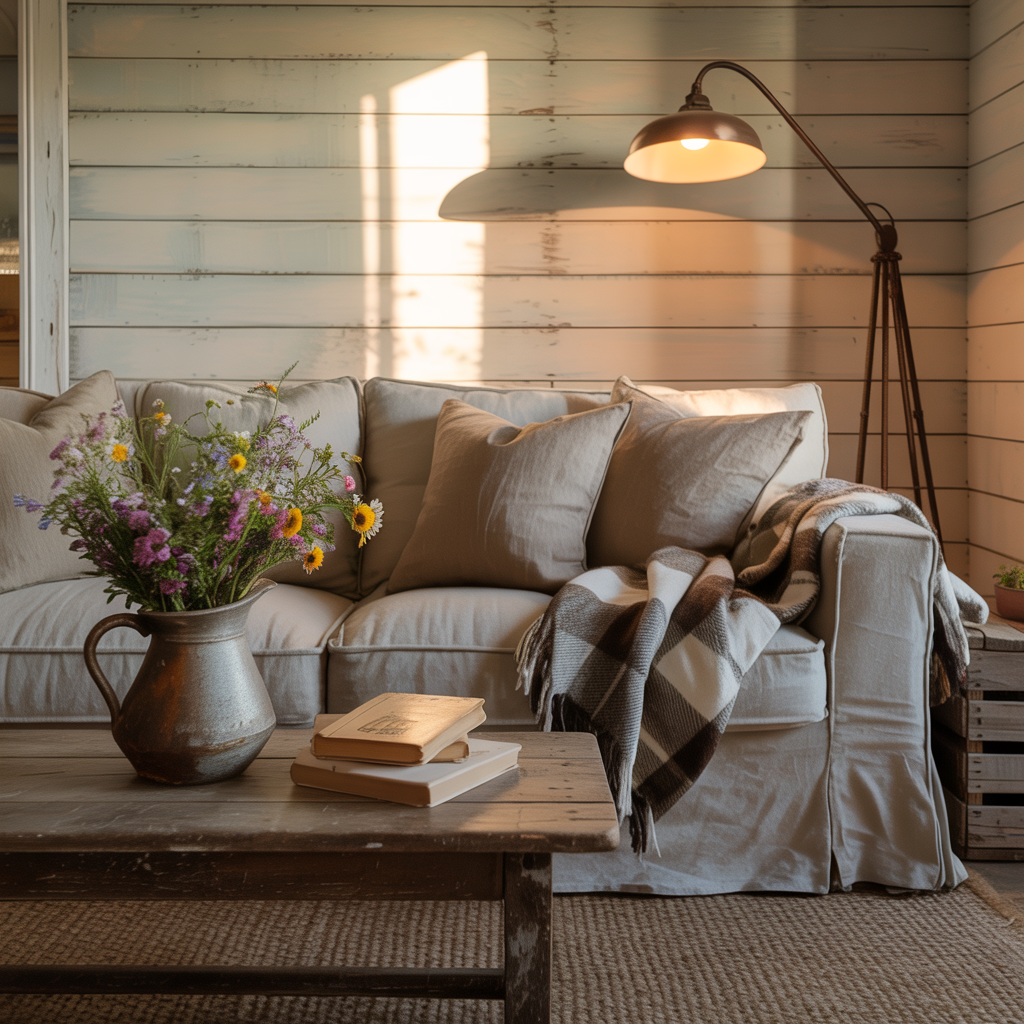
Farmhouse style, when done authentically, brings a sense of history and handcrafted beauty that feels both comfortable and sophisticated. The key is choosing elements that feel genuinely rustic rather than artificially distressed – pieces that tell a story and bring character to your space.
Shiplap walls, when used thoughtfully, add texture and visual interest without overwhelming the space. Rustic wooden furniture – perhaps a coffee table made from reclaimed barn wood or side tables with visible grain and natural imperfections – brings warmth and authenticity. The colors should feel warm and natural: soft whites, warm grays, and muted earth tones that reflect the farmhouse’s connection to the land.
Textile choices become especially important in farmhouse design. Plaid blankets, linen cushions, and woven throws add comfort and softness, while metal accents in aged brass or wrought iron provide contrast and visual interest. The overall feeling should be one of relaxed comfort a space where you can put your feet up and feel completely at ease.
8. Add Unexpected Richness with Deep Blue Accents
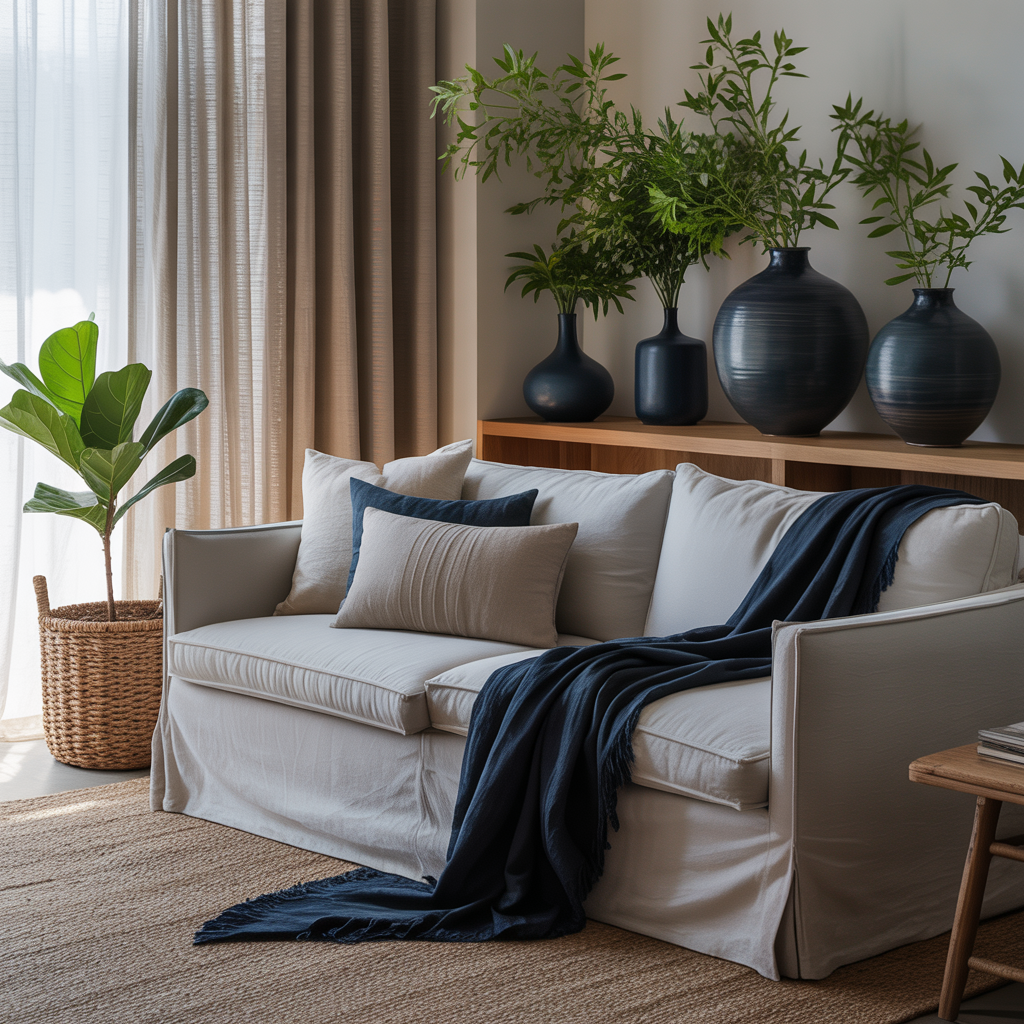
While blue might not be the first colour that comes to mind when thinking about earthy design, deep blues like navy and cobalt can add unexpected richness and sophistication to natural colour palettes. These deeper blues complement rather than compete with warm browns, soft beiges, and natural wood tones, creating a colour story that feels both grounded and elevated.
The key to incorporating blue successfully is using it as an accent rather than a dominant color. A textured navy throw draped over a gray couch, deep blue ceramic vases on natural wood shelves, or curtain panels in rich indigo can add depth and visual interest without overwhelming the earthy foundation. Blue works particularly well against warm wood furniture and natural textures like jute and linen.
What makes blue especially powerful in earthy spaces is its connection to natural elements – think of deep forest lakes, twilight skies, or the rich blue-green of certain stones. When used thoughtfully, blue brings a sense of calm and depth that enhances rather than detracts from the natural, grounded feeling you’re trying to create.
9. Layer Cozy Textiles for Ultimate Comfort
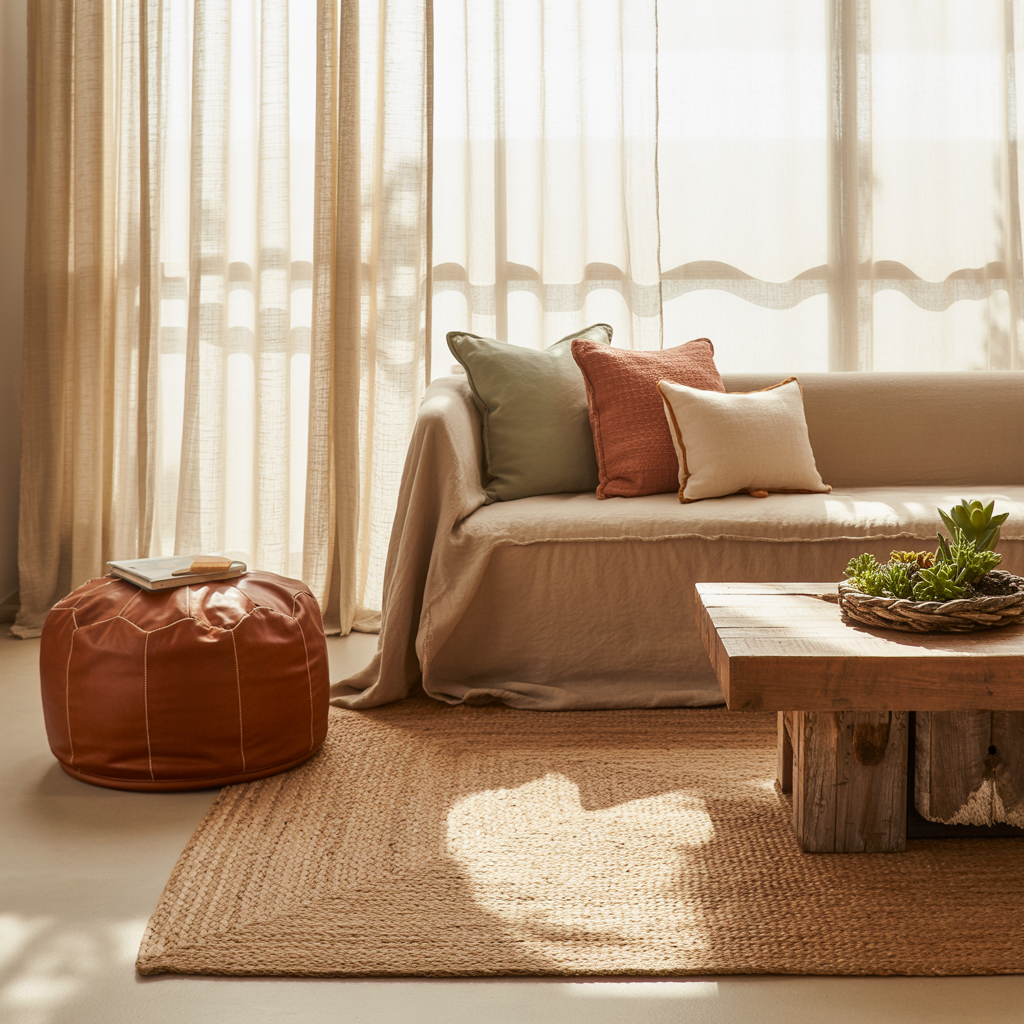
In earthy living room design, there’s truth to the saying that you can never have too many textiles. Layering soft throws, textured rugs, and plush cushions creates not just visual richness but also tactile comfort that makes your space irresistibly inviting. The key is choosing textiles in warm, earthy tones and varied textures that work together harmoniously.
Start with your largest textile element – typically an area rug that anchors the seating area. Look for rugs with subtle patterns or rich textures in natural materials like jute, wool, or cotton. From there, layer throws and cushions in complementary colors and textures. A chunky knit throw in oatmeal, linen cushions in soft sage, and a leather pouf in warm cognac create a palette that feels both sophisticated and comfortable.
Window treatments deserve special attention in this layered approach. Sheer linen curtains or natural cotton panels allow light to filter gently into the room while adding another layer of soft texture. The goal is to create a space where every surface invites touch and every seating area promises comfort.
10. Bring in Living Elements for Authentic Natural Energy
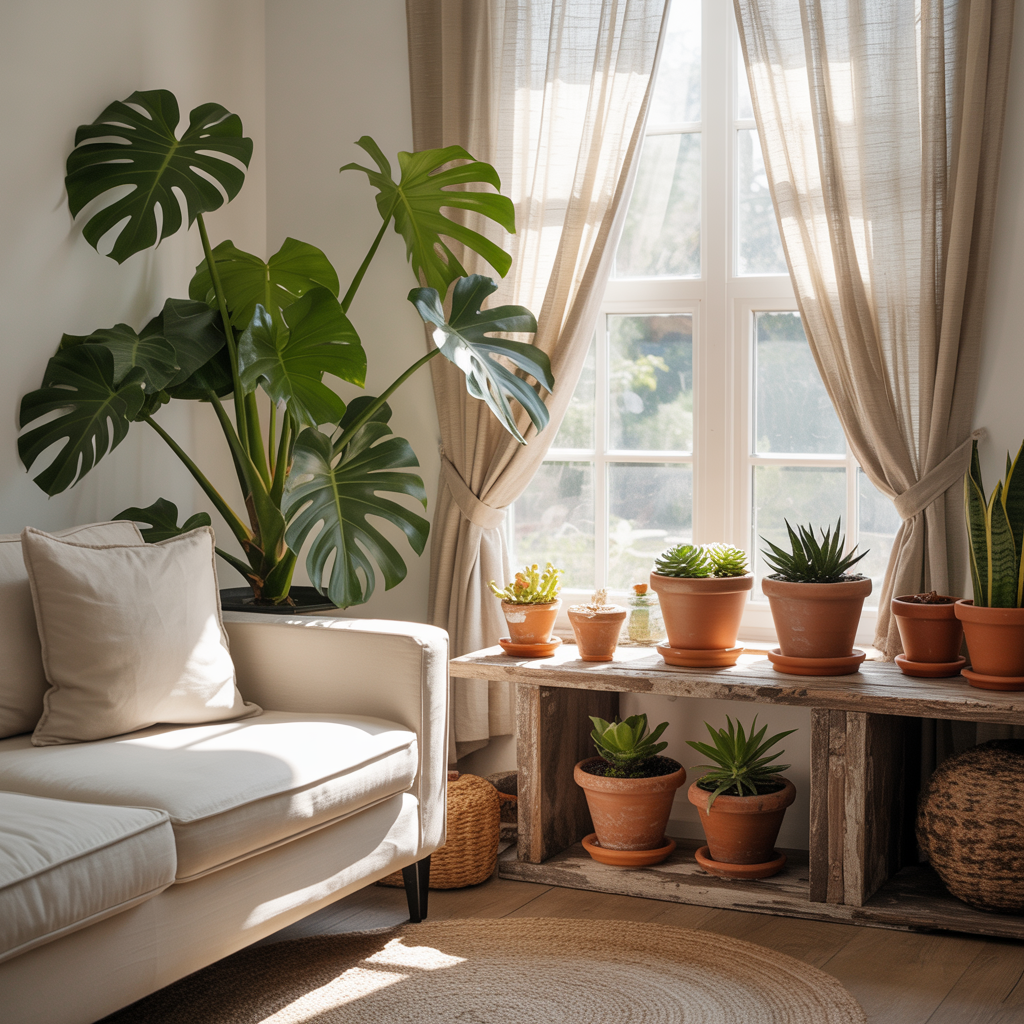
No earthy living room is complete without the presence of actual living plants. While decorative elements can suggest nature, nothing replaces the authentic energy, air-purifying benefits, and ever-changing beauty that real plants bring to a space. The key is choosing plants that thrive in your specific conditions and arranging them thoughtfully throughout the room.
Large statement plants like monstera, fiddle leaf figs, or snake plants can serve as living sculptures, adding height, drama, and organic shapes that contrast beautifully with furniture’s geometric lines. Smaller plants clustered on shelves, side tables, or plant stands create layers of green that add depth and interest to the space.
Consider the containers as part of your design strategy. Natural materials like terracotta, ceramic, or woven baskets enhance the earthy aesthetic while providing homes for your plants. Different heights, textures, and sizes of planters create visual variety while maintaining the natural theme. Remember that plants are living, growing elements they’ll change over time, adding to your room’s evolution and keeping it feeling fresh and alive.
Creating Your Personal Earthy Sanctuary
Designing a cosy, earthy living room is ultimately about creating a space that nurtures both your aesthetic sensibilities and your need for comfort and connection. The natural elements we’ve explored – from the grounding presence of a well-chosen couch to the living energy of plants – work together to create environments that support relaxation, conversation, and the simple pleasure of being at home.
The beauty of earthy design lies in its flexibility and timelessness. These natural elements and color palettes won’t go out of style because they’re rooted in our fundamental connection to the natural world. Whether you choose to make a bold statement with a green accent wall or prefer the subtle sophistication of layered neutrals, you’re creating a foundation that will continue to feel relevant and comfortable for years to come.
Remember that the most successful rooms are those that reflect their inhabitants’ personalities and lifestyles. Use these natural touches as starting points, but don’t be afraid to add personal elements that make the space uniquely yours. A collection of vintage books, family photographs in natural wood frames, or handmade ceramics from local artisans can add the personal touches that transform a beautifully designed room into a true home.
The goal isn’t perfection – it’s creating a space where you feel genuinely comfortable and connected to the natural world, even when you’re indoors. Trust your instincts, embrace the imperfections that make spaces feel lived-in and loved, and enjoy the process of creating your own earthy sanctuary.

Add a Comment